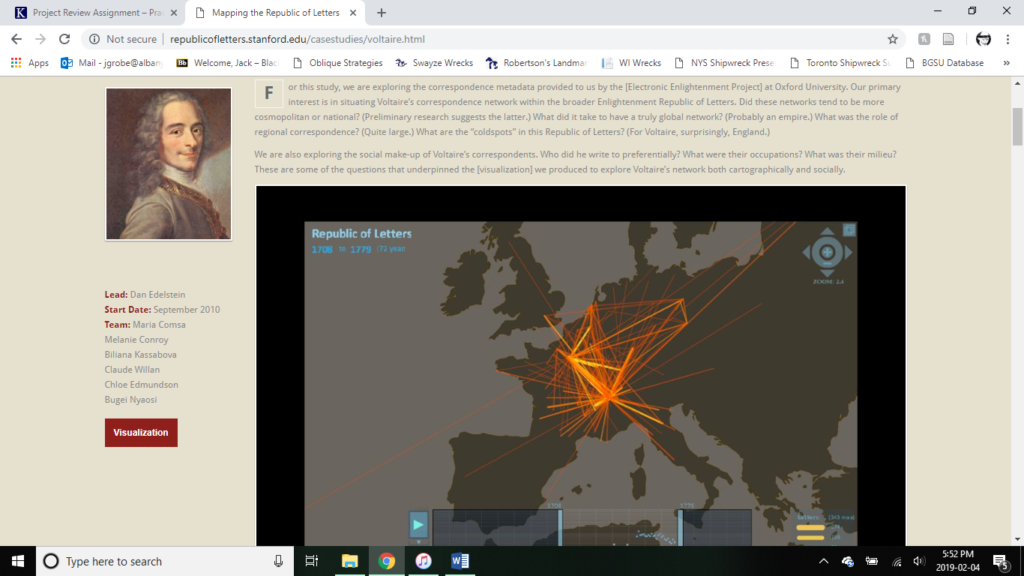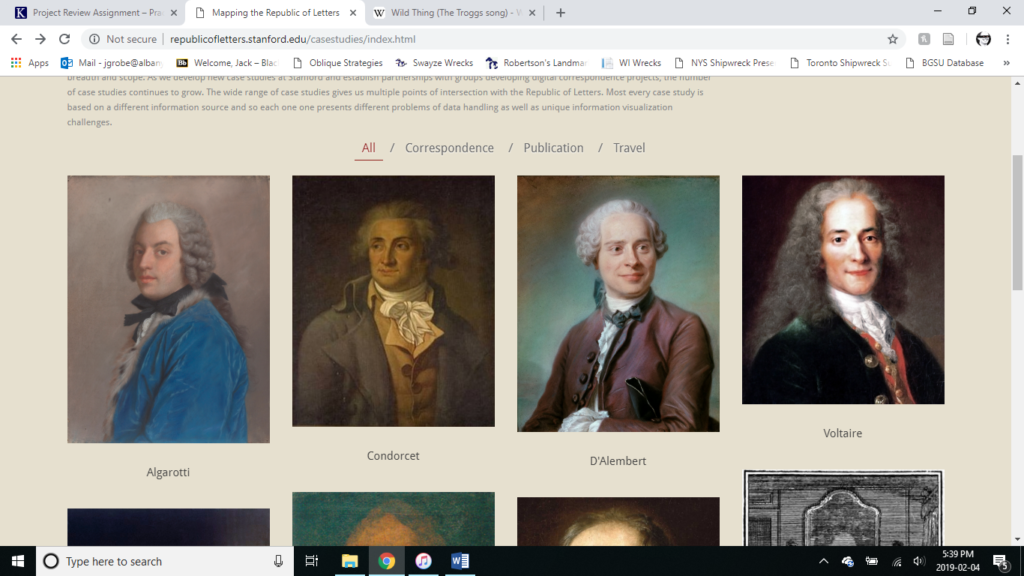Mapping the Republic of Letters Review
Mapping the Republic of Letters. http://republicofletters.stanford.edu/#. Stanford University? http://republicofletters.stanford.edu/contact.html. February 04, 2019.
Mapping the Republic of Letters is a huge dataset of primary sources and accompanying digital analysis. I cannot overemphasise the sheer size of this project. It is overseen by three persons, with a total of sixteen distinct contributors. Of those, three have contributed to more than one subproject, with the highest being three. There are 12 subsections, with each subsection of a case study containing as much information as the Pox Americana digital project. To call this a single project is a bit misleading as the various subprojects have certain levels of distinctiveness, betraying their creation by different scholars.
This project functions both as a digital narrative/database as well as a digitalized archive. The primary documents present are comprised of correspondence, travel logs, and notes. Not all three are available for every person studied however. These are paired with secondary digital analysis, spatial maps and neural networks, of the intersections between these collections and thinkers. Frequently, comparisons are made to other subprojects (ex: mapping Voltaire’s network as compares to Lockes).

The overall project seems to be aimed at a scholarly audience. The amount of information contained is larger and more detailed than the average passing viewer is interested in as well as too bulky for a teaching aid in a classroom. The premise of the database is to reinforce the importance of social networks among intellectuals at the time as well as mapping out the intersections of thought and correspondence. There is also not a ton of interactive material, as pages exist mainly to subdivide the material into more easily consumable chunks. Some sections attempt to be interactive, but page errors like a failure to render a map or link dots with presentable info prevent this:

Navigation on the site is clear enough, with archival materials and analysis being presented in three categories being on the type of primary document being utilized: Correspondence, Publications, and Travel. The thinkers can not be grouped by nationality or subfield.

Despite the organization, it is very easy to get lost on the site given the huge amount of material. There are records available for intellectuals of England/the United Kingdom, France, Italy, and Spain. Records refer to other locations (like Italy) in the context of visitors to there from one of the three main empires studied. English thinkers are best represented along with the French. Spain is presented as a single entity without being broken down into individuals. Notably missing are Dutch, German, and Eastern European thinkers. The lack of the latter is understandable due to issues of preservation, but where are the Dutch like Antonie van Leeuwenhoek?
In the end, given the massive size and detail of this project and its subprojects, Mapping the Republic of Letters appears to offer itself most easily to scholars seeking to understand networks of thought and communication during the Age of Discovery. The amount of digital mapping of both spatial distance of correspondence as well as neural networks of correspondents is displayed most easily in a digital format. The maps could be printed off and consumed offline, but lack of interactiveness notwithstanding, this project is most easily consumable in a digital format.
This massive undertaking provides invaluable information and analysis for scholars studying the thinkers and intellectual networks of the Age of Discovery. With the addition of Dutch, Portuguese, and other passed over thinkers, this project will only become more valuable.
One Comment
Maeve Kane
How do you understand this project historiographically? Eg, is it possible to position it the way you would a monograph in a field you’re unfamiliar with just going by what’s presented?